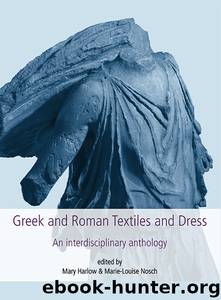Greek and Roman Textiles and Dress by Unknown

Author:Unknown
Language: eng
Format: epub
Tags: CRAFTS & HOBBIES / Weaving, TECHNOLOGY & ENGINEERING / Textiles & Polymers
ISBN: 1992164
Publisher: Oxbow Books, Limited
Published: 2014-09-29T16:00:00+00:00
9. The Wool Basket: function, depiction and meaning of the kalathos
Elisabeth Trinkl
Working outside the house was a typical male activity whereas working within the house was the responsibility of women; so ancient authors tell it.1 One characteristic task falling within women’s remit is ‘wool working’, including various work stages from preparing the raw material to the final production of textiles. In the following I will not go into details concerning this fundamental fact though. The tools needed for these tasks, (such as spindle, distaff, loom weights etc.) have already been discussed in detail and from different aspects elsewhere.2 Within these discussions not much attention was drawn to one object related to wool working: the container used for gathering and storing raw wool as well as wool processed into yarn,3 the wool basket, kalathos or calathus/quasillum.
Basketry is a very old craft; processing unspun fibres, it is based on a technique closely related to weaving and is older than the craft of producing fabrics using spun threads. Baskets are made in a way similar to that used for woven mats, and the same technique was used for the production of clothing in a time when textiles of finer fabrics were not yet manufactured.4 Baskets were made of organic material, therefore little evidence of these early crafted products survives; this concerns baskets of historic times to almost the same degree.5 Only very special environmental conditions preserve fibre and wickerwork, lodged in the degradation product of other materials (such as the corrosion of bronze or iron, or in salt); mineralised, in water saturated layers; or regions with a constant, extremely dry climate. However, most of the time, fibre and wickerwork are preserved indirectly, for instance as imprint – by chance or intentionally – in soil, clay or mud;6 or as a negative in ash or lava. Indirect information about these lost items made of organic material can be gained by depictions of baskets; further, some objects made of more resistant material such as clay or stone reflect those usually made of perishable material in form and shape.
Essentially, basketry can be divided into two separate techniques which differ in the way the individual strands are interlaced: in the case of the coiled work (winding) parallel strands are connected with each other by weaving more flexible elements through them; while the ‘true weave’ (intertwined) consists of separate elements which are interlaced at (more or less) right angles.7
Baskets can be used in various ways and exist in various shapes. The form and shape of each basket is strongly related to its function: with and without lid, with circular or oval base, cylindrical or angular, with or without handle or with feet, in which case they are mostly used for foods.8 Some baskets are made for a very specific purpose, which is indicated by their distinctive shape; for instance grain swing, press basket, or the kanoun, a Greek basket with three handles, used for offerings.9
The kalathos is principally a multifunctional basket. Literary sources report that, depending on the
Download
This site does not store any files on its server. We only index and link to content provided by other sites. Please contact the content providers to delete copyright contents if any and email us, we'll remove relevant links or contents immediately.
POP by Steven Heller(3307)
Japanese Design by Patricia J. Graham(3109)
The Power of Broke by Daymond John(2897)
Architecture 101 by Nicole Bridge(2764)
Indistractable: How to Control Your Attention and Choose Your Life by Nir Eyal(2334)
Fusion 360 for Makers by Lydia Sloan Cline(2308)
Batik by Rudolf Smend(2123)
Actionable Gamification: Beyond Points, Badges, and Leaderboards by Yu-kai Chou(2122)
Origami Art by Michael G. Lafosse & Richard L. Alexander(2065)
Homebody by Joanna Gaines(2031)
Whiskey in a Teacup by Reese Witherspoon(1936)
Worn in New York by Emily Spivack(1926)
Feng Shui by Stephen Skinner(1900)
Austin Kleon by Steal Like an Artist(1887)
Simple Gatherings by Melissa Michaels(1855)
Don't Make Me Think, Revisited: A Common Sense Approach to Web Usability by Steve Krug(1826)
Hygge: The Danish Art of Happiness by Marie Tourell Søderberg(1693)
The Joy of Hygge by Jonny Jackson(1685)
The Laws of Simplicity by John Maeda(1568)
